
Introduction
The
advantages of moveable boards
The
practicalities of making moveable boards
Rotation of beds and paths
Polythene
and netting protection
Keeping
beneficial animals away from crops
A
fleece-bed
Plastic
boards?
Paths
See also other gardening pages:
Gardening/construction: introduction, with photos
Structures: plant protection and support
Structures: cloches, greenhouse, store / shed
Composting, rainwater collecting
Some design principles in gardening
My page
Sheffield allotments: problems and resolution includes general gardening
information
Introduction: the disadvantages of surrounding beds with
boards
The disadvantages if the boards are fixed in position,
that is - the system used in just about every case when gardeners surround their beds with boards. The boards clearly and neatly separate the cultivated areas from
the paths, and by only walking on the paths, the soil in the cultivated area
stays uncompacted. There are advantages in using boards but only a few of
them have been explored. Unless reclaimed timber is used, boards cost money -
this deters many gardeners from using them. Once it's realized that boards
have many uses, that they can save money overall, then the arguments for using
them are very strong. But this requires a fresh approach to using boards.
When
gardeners use boards to surround beds, in almost every case they use a
system of four boards connected at the corners, the boards fixed in
position. Despite its enormous popularity, this is a poor system in many or
most circumstances, one with multiple disadvantages. (I refer to it here as
'the usual system.') The usual system is very inflexible. Boards
can be used for many different purposes, and the usual system fails to make
use of almost all of them. It has other disadvantages as well. I describe
some of the disadvantages here, and the advantages of the system I've
devised, one which uses self-supporting boards. The images on the right show
boards used in this new system, not boards fixed in position in the usual
way.
After using my system for many years, I have experience of every aspect. I
don't discuss every aspect of the system here, although the information I do
provide is quite detailed. I omit some information about construction of
self-supporting boards and I omit information about some further uses of the
system, such as its advantages in sowing seeds and planting crops. I provide only a little information about some techniques, such as
the use of 'fleece beds' and the use of weed-control fabric in the
system.
The page on Composting and other gardening techniques outlines the
disadvantages of the traditional wooden composter, in which the boards are
fixed, like the fixed boards in the usual system for enclosing beds.
My improved wooden composter overcomes these disadvantages by the use of four separate panels supported
by stakes. This system allows the composter to be moved to a new location
very easily and has other advantages, including the fact that the composter
can be placed on sloping ground.
The advantages of moveable boards
-
In the usual system,
timber is in contact with soil: in building work, this would be regarded
as a fault. In my system,
boards have little or no contact with the soil and are far less vulnerable
to decay than the boards which rest on the soil, as in the usual system.
The boards will last much longer and keep their appearance for much longer.
-
I often use beds
which are 120cm wide, so two of the boards, at least, are 120cm apart. Simply
move these two boards closer together (not possible in the usual system) bend a sheet of PVC plastic into
a semicircle and place it between the two boards - an almost instant
cloche!
It's cheaper than
even a cloche made of polythene (and of course it will last much longer).
The cloche can be removed to work on the bed very quickly - or it can simply
be slid along to allow access, with the boards acting as grooves. The boards
give the cloche great security and it will withstand high winds, but for
greater security, two or three loops of twine (I use baler-twine) can be
used over the PVC. The twine is fastened to the boards, or, to reduce access
time, to tent-pegs, the twine acting like the guy-ropes of a tent. This
design is amongst the ones illustrated on the page on
cloches.
-
Similarly for
netting
protection.
-
The new system allows for
an 'open' as well as a 'closed' bed.
-
In a closed bed, there are boards on
all four sides of the rectangle. This is the only configuration possible
in the usual system, but it can be pleasing (and cheaper) to
use single boards to separate adjoining beds, to use two opposite boards
to mark out a bed, or to use three. I refer to single boards as 'dividers.'
Three of these dividers are shown in the diagram above. The use of dividers allows different
crops to be separated and give complete flexibility. The dividers can be
moved at any time.
-
The boards can be used
to keep in place black landscape fabric used to eliminate weeds from new
land: again, not possible in the usual system. Fabric secured in this way isn't affected by the strongest gales.
When the fabric is 'secured' by rocks, bricks or pegs, the fabric can be
moved or damaged all too easily.
-
So many garden
operations - weeding, raking, sowing, harvesting are more difficult when
the fixed boards of the usual system are adopted. Fixed boards get in the way.
For example, I often use a powerful flame weeder. Using a flame weeder near
to fixed boards scorches the boards! Since the boards in my system can be removed so
easily, a wheelbarrow can be taken into the bed, a very great advantage:
no need to park the wheelbarrow on a path beside the bed and carry heavy
loads from wheelbarrow to the centre of the bed, if that's where the load
is to be deposited. The easily removeable boards of this system allow
unobstructed access.
-
It's recommended that
the gardener shouldn't walk on the soil when the system of raised beds is
used. Walking compacts the soil and damages the structure of the soil. When
working on a bed, the gardener has to find something suitable to stand on.
In my system, unlike the usual system, the boards can be removed in a moment and laid on the soil
to form temporary paths. The gardener can kneel on the boards rather than
on the soil. The boards can make sowing, planting or harvesting in the interior
of the beds, the areas furthest away from the paths, much easier. By using
them, beds which are 150cm or 200 cm wide - wider than the recommended distances
for raised beds - become quite practicable. Boards can be taken to areas
which have not been divided into beds - areas which are more like farmland
than a system of raised beds - and used as temporary paths, to avoid soil
compaction. See also the image below: the two horizontal boards were used
for walking on whilst planting potatoes. After being used for this purpose,
the boards were used for their original function, defining the boundaries
of a bed.
-
This system, unlike
the usual system, gives the
freedom to modify the size and shape of beds very easily. This may be for
practical reasons. For example,beds which are 120cm wide are convenient
for many purposes but not all: too narrow for potato-growing, if
three rows are used along the length of the bed. By moving the longer boards
out, the width can be increased to 140cm or thereabouts. Many of the beds
I use are 240cm long but some of the PVC sheets I've bought to make cloches
are 244cm long. The PVC sheets obviously can't be used in a system of fixed
boards. My system allows the end boards to be moved very easily to extend
the length of the bed. When the cloches are no longer needed, the boards
can be moved back to their original position. The freedom to adjust the
placing of the boards allows us to alter the design to make it more functional
- or more harmonious, more pleasing, more beautiful. Growing beds should
be flexible, easily changed as our knowledge and experience grow, as our
priorities change. We may have started out with a strictly utilitarian view
of our plot, but may find that the urge to create beauty is compelling,
and that we can combine the useful and the beautiful. We may find that with
realignments of beds we can create new vistas, dramatic contrasts - if so,
this way of supporting boards will allow us to do so. (However, it isn't
always easy to combine the utilitarian and the beautiful in vegetable growing
- there's nothing at all wrong with a plain and functional plot.) The
usual system is inflexible and offers none of these advantages.
The practicalities of making moveable boards
A
cheap and easy way to make beds surrounded by moveable boards, if you can't
obtain reclaimed timber: you buy 3 gravel boards, each 2.4 metres long. You
saw one of these in half to make the two end sections, each 1.2 m long. The
other two boards make the two longer sections. You attach a metal stake half way
along each board and push the stakes into the ground. After perhaps ten minutes
work you have a boarded bed which is 2.88 metres square and at a total cost
of a little under 13.00 - about £3.00 for each gravel board and about
£1.00 for each metal stake. To be more exact, you have not just a boarded bed
but a bed whose boards have many different useful functions (not all of them
described here.)
The metal
stakes used to support the boards are simply fixed to the board
with screws, using the holes already drilled in the stake. The screws
will almost certainly work loose before long, however. The secure fixing method I use
is a little more elaborate, but not very much, and it's quick to implement.
It solves the problem.
There
are small gaps between the borders at the corners, but small metal corner
plates are easy to obtain, even if they're not designed specifically for this
function. The boards aren't fixed to these plates. By using them, the bed
will look just as neat as any bed which uses the usual inflexible system of
boards fixed to corner posts -

I use single self-supporting boards
('dividers') to a greater extent than four boards surrounding a bed, but
dividers are similarly easy to make, at a cost of around £4.00 each.
Rotation of beds and paths
Rotation of crops is a standard technique in growing. But it can be
useful to rotate beds and paths! Here, I describe only a very simple system,
in which beds and paths are equal in area. The same principles apply if, as
is usual, beds take up a greater area than paths. I don't provide any
detailed information about management of the system.
In an ideal gardening world, people who take over a weed-infested plot
would put down light-excluding fabric to eliminate annual and perennial weeds
and wait a year before sowing and planting. In practice, they are often
understandably impatient and begin sowing and planting sooner than that.
(They have previously divided the plot into beds and paths and laid down
light-excluding fabric on the paths, covered with wood-chips, perhaps.)
In an ideal gardening world, people who did clear the plot completely
wouldn't begrudge in the least the time and effort needed to keep the plot
clear of weeds. In practice, they understandably fail to do that. The
never-ending work becomes a burden and the plot begins to look bedraggled.
They wish they had pristine, weed-free soil again, the soil they had for
such a short time just after they'd eliminated all the weeds.
They do, of course! It's
very near at hand, underneath the paths. The weed-control
fabric on the paths has killed the weeds and prevented any weeds from
growing. If the fabric is moved to the beds then the paths can now be used for
cultivation.
Polythene cloche and netting protection
If
polythene or netting (not free of charge, but very cheap) is stretched between
the boards, we can make the whole of a bed into a low cloche, or a protected
area: a cloche-bed or a netting-bed. (The
fleece-bed is covered in a later section.) This idea - which
isn't a new one - isn't implemented very often, perhaps because the disadvantages
are obvious. Although it's easy to staple polythene or netting to the fixed
framework of the four boards, what do we do if we want to weed or harvest?
Remove the staples? The difficulties disappear if we use boards which are
supported by stakes - one or two stakes for each board - so that the boards
can be moved very quickly. By moving a board towards the centre of the bed,
we have access to half the bed. Move the opposite board, and we have access
to the other half. It's as simple as that - far easier than removing commercially
available cloches or netting systems.
In
pictures - netting is stapled to boards. Polythene could equally well have
been used, to form a low cloche.
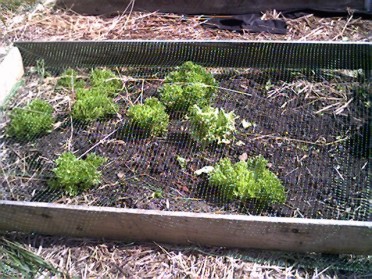
Since
the boards are supported by stakes, each board can be moved very easily, towards
the centre, allowing weeding or harvesting to be carried out on half the area
of the bed. By moving the opposite board, we have almost immediate access
to the other half of the bed.
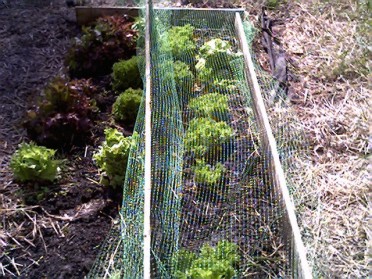
If
the boards are 15cm high - a typical height - then that's high enough for
any plants in the earlier stages of their growth, the stages when we very
often use cloches. These include early potatoes, which can be planted much
earlier by using this system - the end of February, unless the temperature
is very low. You could achieve the same result by using commercial cloches,
but this wouldn't be a cost-effective solution at all. Low-growing plants
such as lettuce can be covered by polythene or netting throughout their growth.
By
using another board in the middle of the bed, supported by one or two higher
stakes, we can easily increase the height of the system, to accommodate taller
crops. When polythene is used to make a cloche, there's the further advantage
that the cloche sheds rainwater more easily. If this middle board isn't used,
and the polythene sheet is flat, then small holes can be made in the polythene
so that rainwater doesn't collect and weigh down the polythene.
Keeping
beneficial animals away from crops
It's
easy to see that the netting-bed I've already described is very useful in
protecting a crop, keeping birds away from strawberries, for example. How
can it possibly be an advantage to keep beneficial animals from crops? I'm
referring in particular to hedgehogs, frogs and some birds.
If lettuces or other crops are grown inside the protected area, then it's
perfectly safe to use pellets to kill slugs and snails, and it's impossible
for hedgehogs, frogs and birds to be harmed by them. This isn't a novel idea,
but in order to protect beneficial living things from slug pellets, it's important
that the protection system should be convenient to use. So far as possible,
the common and routine work of the garden or allotment should be part of a
fluid 'work flow.'
I
favour, I practise organic growing, but I see every reason for diverging from
strict organic practice in a few limited areas, above all in the case of slug
and snail control.
I
know that there are many organic gardeners who feel as I do - who make an
exception in the case of slugs and snails. (I refer to this as the practice
of limitation, the abandonment of complete consistency, of
organic 'purity,' in this case, when reality seems to call for it.) To give
one example, from Margaret Elphinstone's and Julia Langley's 'The Organic
Gardener's Handbook:' we read '...even on beautifully drained raised beds
there can be enough slugs in early spring to devastate the struggling cloche-grown
lettuce and carrots, or the newly-germinating runner beans. In recent years
I have been desperate about the devastation, and have resorted to dangerous
metaldehyde bait.' But when it's impossible for beneficial animals and birds
to be harmed by the bait, then the only valid objections, I think, are ones
based on maintaining complete organic consistency.
Alternative,
non-chemical methods all have disadvantages. I do what I can to help beneficial
animals in my allotments, but not simply because they are useful. Their welfare
is important. Without wishing, of course, to criticize these beneficial animals
in the least, their efforts do fall short of controlling slugs and snails
effectively enough in all circumstances! Traps containing beer or another
attractant kill beneficial creatures as well as slugs and snails. Removing
them by hand (preferably a gloved hand) and disposing of them by whatever
method is favoured, is time-consuming, has the disadvantage of being a
nocturnal activitiy and is unpleasant to most people. Biological control
by nematodes is expensive. Time after time, you're likely to see all your
hard work ruined, to find your seedlings decimated, like chickens after a
fox has done its worst.
I
oppose the notion that because a method is supposedly, or actually, more 'virtuous,'
for example in not involving the use of manufactured chemicals, that all the
advantages lie with this method and all the disadvantages with less virtuous
methods. I refer to this as the practice of alignment, all
the advantages on one side, all the disadvantages on the other. Alignment
ignores complexities and inconvenient facts.
Another
concept I use is that of the ((survey)), which involves this
attempt to list all the considerations which are relevant, based on information
which is as complete as possible, but not simply information: on values too,
including ethical values, aesthetic values. Many criticisms of organic practice
are based on a ((survey)) subject to severe
{restriction}. If it could be shown that pesticide
residues in fruit, vegetables and grains are not at all a substantial hazard,
and the claim is then made that organic methods are unnecessary, then the
((survey)) used is inadequate, ignoring the benefits to wildlife, as
well as other benefits. Many criticisms of non-organic practice are based on
an inadequate ((survey)) too.
A fleece bed
This
is deliberate exaggeration. I don't in the least deny the usefulness - the
necessity - of a
greenhouse or polytunnel for all sorts of purposes. But for some purposes,
people who have a greenhouse or polytunnel would do better to use fleece instead.
(The possession of a tool or piece of equipment doesn't guarantee that using
it will always be the best course of action.) For these same purposes, people
without a greenhouse or polytunnel need feel under no disadvantage.
In
particular, 'starting the plant off' is better achieved in situ, in the place
where the plant will grow to maturity, than in a greenhouse or polytunnel,
if at all possible. To state the obvious (and at some length, in this paragraph
and in the next few paragraphs) if a plant is started off in a greenhouse
or polytunnel, then we have to move the plant from there to the place where
it will grow to maturity. However, not just move 'the' plant but often many,
many plants. If the plants are started off in the greenhouse or polytunnel,
then they have to be watered. Outside, unless there are drought conditions,
they will be watered for us.
Sowing seeds directly
in the soil can be carried out very rapidly. Very often, we can use a dibber,
which is quicker to use than a trowel and which involves a better 'work flow.'
For all but tiny seeds, push the dibber into the soil, drop in two seeds,
push a little soil over them and move on. The use of a greenhouse or polytunnel
demands that we sow seeds in (peat-free) compost in individual pots or root
trainers, and that we later transport perhaps a few dozen, a few hundred or
a few thousand young plants to the bed where they will grow to maturity and
there dig a few dozen or a few hundred or a few thousand little holes with
a trowel to receive the plants. Sometimes, the work involved in all this deters
a gardener from growing enough plants. Providing there is enough space available,
there's the need to 'think big.' In the case of broad beans and peas, for
example, a great many plants will be needed to produce adequate crops, taking
into account the amount of broad beans or peas left after shelling.
If these broad bean seeds
rot in cold, wet soil, early in the season, if young runner bean plants or
French bean plants are killed by late frosts, then of course there won't be
any saving in time or effort, but the use of fleece minimizes this possibility.
Fleece should be put in place some weeks before the time for sowing the seeds,
so that the soil is warmer by then. All of this is established knowledge of
course. Very many gardeners and allotment gardeners do use fleece and are
fully aware of its advantages. I use my system to make
'fleece beds.'
Plastic boards?
With a plastic water butt, a plastic composter and beds surrounded by plastic
edging boards, all we need are plastic flowers to complete the look. I do
support the use of plastic for water butts, as the most practical
material in most cases, but plastic has obvious disadvantages for some
gardening uses.
Plastic becomes brittle under the action of UV light, and then it has to be
disposed of. Plastic can't be recycled any number of times. At the end of
its (quite short) useful life, the eco-friendly plastic boards will probably
end up in a land-fill site. There's an energy cost in manufacturing a product
made from recycled plastic - another contribution to global warming. It makes
no sense at all to use plastic for edging boards, when the alternative, wood,
a renewable resource, is clearly superior. The wood may be pressure-treated
or untreated - it's best to use untreated wood, even if the risk to plants
and the environment in general from the chemicals used to treat wood is very
small. Whether treated or untreated, the wood will last longer than plastic
in my system, since the wood is raised above soil level by the metal stake.
It's wood resting on soil which rots the fastest, by far. The inside of the
wooden boards will decay faster than the outside, but this side is hidden
from view. The outside of the board will look good for a very long time.
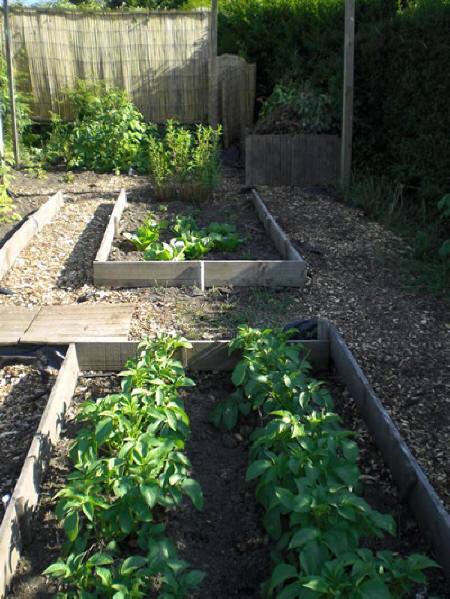
Above, self-supporting boards used to surround a bed on four sides
(foreground), three sides (background, centre) and as a single 'divider'
(background, left). Picture shows part of my upper allotment. None of the
first three photographs in this column show my current practice in these
areas.
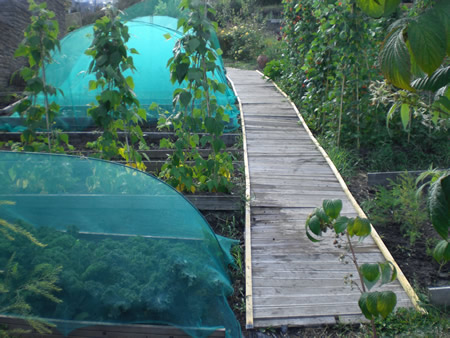
Self-supporting boards used singly, as 'dividers,' on either side of the
path. No boards are needed to mark the boundaries of the beds on the sides
adjoining the paths: the raised edging of the path marks the boundaries. Also
shown: my cage system with flexible supports,
here protecting kale and purple-sprouting broccoli. Picture shows part of my
lower allotment.
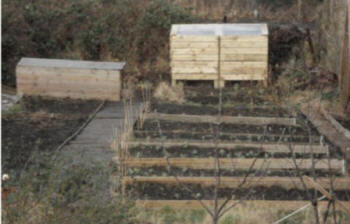
Paths
In my own practice, I make use of three kinds
of paths:
(1) Informal paths not constructed at all - simply routes
where I've walked to get from one place to another particularly frequently,
so that the vegetation is beaten down. Often, these paths may not follow a
straight line.
(2) 'Overpaths.' 'Overpath' is a new term which
reflects the established word 'overpass.' In the past, I've used gently
curved overpaths but now I use straight line overpaths exclusively. Just as
I make use of raised beds, I make use of raised paths. The raised paths are
constructed from wood and raising them makes them last longer, and ensures
that maintenance is at longer intervals. Images of overpaths:
An
overpath in the upper allotment. The boards are laid on an extended
aluminium ladder. The metal is visible on either side of the wood. The path
here has lines of boards on either side, marking the boundaries of beds.
These boards have since been removed.
/DSCF1463.JPG)
An overpath in the lower allotment. The wooden boards are laid on oak
blocks. Some of the blocks can be seen here.
/DSCF1447.JPG)
Another overpath in the lower allotment. It leads from the entrance to
the allotment. This overpath, like the others, doesn't rest on the soil so
that the wood is protected from this source of moisture, if not from
precipitation, of course. All these overpaths have lasted for a long time
without deteriorating very much at all.
I always have an 'informal' path running alongside the overpath. These
informal paths, like other informal paths in the allotment, are always
narrow. Weeds are kept in check on these paths more effectively if foot
traffic is heavy rather than light.
I've made use of 'sheet metal paths,'
with a layer of bark chippings on the sheet metal.
I oppose the use of landscape fabric for
constructing paths but see the need for a base for wood chippings (or other
loose material) to prevent the growth of weeds. I now make use of galvanized, sheet metal, a stable, very
long lasting material which is completely impervious to weeds. The sections
of sheet metal overlap so there are no gaps between the sections which allow
the growth of weeds. Sheet metal isn't expensive - but the sheet metal I use
comes from projects where the sheet metal isn't needed any longer, so that
it's effectively cost-free.
The disadvantages: sheet metal
presents severe hazards. The sharp points at the corners and the sharp edges
need great care in handling the sheets. I've developed methods of reducing
or eliminating the dangers. See
my page
Design-construction-other.
The sheet metal is covered with a layer of bark
chippings, for the sake of appearance, to give a softer surface for walking,
and to eliminate the danger of slipping. The path is on a slope, steeper at
the upper half than the lower half, but on this steeper section, I've put a
layer of heavy-duty wire mesh on the sheet metal, which makes walking secure
and which helps to retain the bark chippings. Bark chippings on a smooth
surface like sheet metal can otherwise move downhill or be washed downhill
during heavy rain.
The design is successful, I think. The path has a
cushioned surface which it's a pleasure to walk on. An area which was
infested with weeds - the informal path in this area was too wide to control
the weeds by walking on them, but the path had to be wide so that a
wheelbarrow could be used - is now weed-free and will stay weed-free for a
long time. Eventually, light weeding will have to be carried out but after
weathering for years, the bark chippings are compostable and will contribute
material high in carbon to add to the green high-nitrogen materials to be
composted.
General considerations:
Whether the paths run between beds or through beds, or parts
of a garden or allotment where there are no beds, paths are a problem, a
problem more difficult to address than the beds.
A comprehensive
((survey)) of the advantages/disadvantages of
a certain kind of path will include such features as cost, ease of
construction, overall durability, ease of maintenance to ensure longer
durability, without a substantial environmental penalty, aesthetics.
Stones slabs laid end to end to form a path will be durable and durable with
minimum maintenance and is likely to look good but will require a great deal
of work to construct. Similarly for paths constructed with cement or tarmac,
although with less aesthetic value, very likely. A path constructed with
only a thick layer of bark chippings will be cheap, particularly if the bark
chippings can be obtained free of charge - transportation will cost
something - and will be much easier to construct but won't be durable
and will require much more maintenance - the removal of weeds.
A path
constructed by putting a thick layer of bark chippings over a length of
weed-control landscape fabric will have similar advantages but will cost
much more and will have environmental disadvantages. Given the problems of
disposal, I oppose the use of landscape fabric in gardens and allotments in
all circumstances. No matter what the difficulties of the alternatives, I
would never use it myself now. I did in the past, and came to the conclusion
that it's hideous material. No gardener should be sending the material to
landfill, but there are no realistic uses for the fabric, unlike old tyres,
and the uses of old tyres in gardens and allotments are difficult or
impossible to justify.
If a gardener does decide to make use of
landscape fabric, the fabric should be covered, with compost, soil, wood
chippings or bark chippings, not left fully visible for year after year.
Whether the garden is for growing flowers or for growing crops or for both,
aesthetic considerations have importance. Bare landscape fabric looks
hideous, I think.